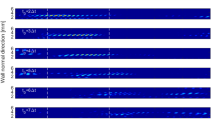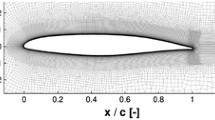Abstract
In the present study, the influence of active cooling on hypersonic boundary-layer transition at different Mach numbers, from 7 up to 10, is investigated. The analyses are carried out on a \(7^\circ\) half-angle, blunted cone with different nose radii and various gas injection mass flow rates. In all cases, low mass fluxes, which do not inducing visible shocks in the schlieren images, are applied. As injection gas nitrogen is used. At the considered free stream conditions, second modes are the dominant boundary-layer instabilities, which are consequently the focus of this study. The stability analyses are performed by means of the stability code NOLOT, NOnLOcal Transition analysis, of the German Aerospace Center (DLR). The influence of different mass injections on the frequencies and growth rates of the second modes is analyzed in detail. The effect on the transition onset locations is discussed. The numerical predictions are compared with experimental results. The experimental data referred to in the present study were obtained in the DLR High Enthalpy Shock Tunnel Göttingen.










Similar content being viewed by others
References
Weihs, H., Hald, H., Reimer, T., Fischer, I.: Development of a CMC Nose Cap for X-3. In: 52nd International Astronautical Congress (2001). IAF-01-I.3.01
Weihs, H.: SHEFEX II Mission Overview and First Results. In: 4th International ARA Days, Arcachon (2013)
Savino, R., Fumo, L.S.M.D.S., Sciti, D.: Arc-Jet testing on HfB2 and HfC-based ultra-high temperature ceramic materials. J. Eur. Ceram. Soc. 28(9), 1899–1907 (2008. https://doi.org/10.1016/j.jeurceramsoc.2007.11.021
Kütemeyer, M., Helmreich, T., Rosiwal, S., Koch, D.: Influence of zirconium-based alloys on manufacturing and mechanical properties of ultra high temperature ceramic matrix composites. Adv. Appl. Ceram. 117(S1), 62 (2018). https://doi.org/10.1080/17436753.2018.1509810
Kendall, R., Rindal, R., Bartlett, E.: Thermochemical ablation. In: AIAA Thermophysics Specialist Conference (1965). AIAA-Paper1965-642
McManus, H.L., Springer, G.S.: High temperature thermomechanical behavior of carbon-phenolic and carbon-carbon composites 1. analysis. J. Compos. Mater. 26(2), 206–229 (1992). https://doi.org/10.1177/002199839202600204
Loehle, S., Staebler, T., Reimer, T., Cefalu, A.: Photogrammetric surface analysis of ablation processes in high-enthalpy air plasma flow. AIAA J. 53, 11 (2015). https://doi.org/10.2514/1.J053728
Kim, S.I., Hassan, I.: Numerical study of film cooling scheme on a blunt-nosed body in hypersonic flow. J. Therm. Sci. Eng. Appl. (2011). https://doi.org/10.1115/1.4005052
Böhrk, H., Wartemann, V., Eggers, T., Martinez Schramm, J., Wagner, A., Hannemann, K.: Shock tunnel testing of the transpiration-cooled heat shield experiment AKTiV. In: 18th AIAA/3AF International Space Planes and Hypersonic Systems and Technologies Conference (Tours, France, 2012). AIAA-Paper 2012-5935
Böhrk, H.: Transpiration-cooled hypersonic flight experiment: Setup, flight measurement, and reconstruction. J. Spacecr. Rockets 52(3), 674 (2015). https://doi.org/10.2514/1.A33144
Schneider, S.: Flight data for boundary-layer transition at hypersonic and supersonic speeds. J. Spacecr. Rockets 36(1), 8 (1999). https://doi.org/10.2514/2.3428
Schneider, S.: Hypersonic laminar–turbulent transition on circular cones and scramjet forebodies. Process Aerosp. Sci. 40(1–2), 1 (2004). https://doi.org/10.1016/j.paerosci.2003.11.001
Morkovin, M.V.: Critical evaluation of transition from laminar to turbulent shear layers with emphasis on hypersonically traveling bodies. Techreport AFFDL-TR-68-149, Air Force Flight Dynamics Lab. (1969). DTIC citation AD-686178
Schneider, S.P.: Hypersonic boundary-layer transition with ablation and blowing. J. Spacecr. Rockets 47(2), 225 (2010). https://doi.org/10.2514/1.43926
Mack, L.M.: Boundary layer linear stability theory. AGARD - special course on stability and transition of laminar flow R-709, 2 (1984)
Mack, A., Hannemann, V.: Validation of the unstructured DLR-TAU-code for hypersonic flows. In: 32nd AIAA Fluid Dynamics Conference and Exhibit (St. Louis, Missouri, 2002). AIAA2002-3111
Schwamborn, D., Gerhold, T., Heinrich, R.: The DLR Tau-code: Recent applications in research and industry. In: European Conference on Computational Fluid Dynamics ECCOMAS CFD (2006)
Reimann, B., Hannemann, V.: Numerical investigation of double-cone and cylinder experiments in high enthalpy flows using the DLR TAU code. In: 48th AIAA Aerospace Sciences Meeting Including the New Horizons Forum and Aerospace Exposition (2010). https://doi.org/10.2514/6.2010-1282
Hannemann, V.: Numerical investigation of an effusion cooled thermal protection material. ICCFD4 (2006)
Reiter, P.: Transition prediction for hypersonic conical flows with gas injection. Master’s thesis, Technical University Braunschweig (2016)
Bottin, B.: Aerothermodynamic model of an inductively-coupled plasma wind tunnel: numerical and experimental determination of the facility performance. Ph.D. thesis (1999)
Esser, B.: Die Zustandsgrößen im Stoßwellenkanal als Ergebnisse eines exakten Riemannlösers. Ph.D. thesis, TH Aachen (1991)
Wartemann, V., Wagner, A., Wagnild, R., Pinna F., Miró Miró F., Tanno, H., Johnson, H.: High enthalpy effects on hypersonic boundary layer transition. J. Spacecraft Rockets (2018). https://doi.org/10.2514/1.A34281
Wagner, A.: Passive hypersonic boundary layer transition control using ultrasonically absorptive carbon–carbon ceramic with random microstructure. Ph.D. thesis, Katholieke Universiteit Leuven (2014)
Hein, S., Bertolotti, F.P., Simen, M., Hanifi, A., Henningson, D.: Linear nonlocal instability analysis - the linear NOLOT code. Tech. Rep. IB-223-94 A56, DLR (1994)
Wartemann, V.: Mack-moden-dämpfung mittels mikroporöser oberflächen im hyperschall. Ph.D. thesis, Technische Universität Braunschweig (2014)
Wagner, A., Stuart, L., Martinez Schramm, J., Hannemann, K., Wartemann, V., Lüdeke, H., Tanno, H., Ito, K.: Experimental investigation of hypersonic boundary-layer transition on a cone model in the High Enthalpy Shock Tunnel (HEG) at Mach 7.5. In: 17th AIAA International Space Planes and Hypersonic Systems and Technologies Conference. International Space Planes and Hypersonic Systems and Technologies Conferences (2011). https://doi.org/10.2514/6.2011-2374
Pagella, A., Rist, U., Wagner, S.: Numerical investigations of small-amplitude disturbances in a boundary layer with impinging shock wave at Ma = 4.8. Phys. Fluids 14(7), 2088 (2002). https://doi.org/10.1063/1.1480265
Fedorov, A., Soudakov, V., Leyva, I.: Stability analysis of high-speed boundary-layer flow with gas injection. In: 7th AIAA Theoretical Fluid Mechanics Conference. AIAA AVIATION Forum (2014). https://doi.org/10.2514/6.2014-2498.AIAA2014-2498. AIAA2014-2498
Saric, W.: Physical description of boundary-layer transition: Experimental evidence. Tech. rep., AGARD Report 793: Special Course on Progress in Transition Modelling (1994)
Gronvall, J., Johnson, H., Candler, G.: Boundary-layer stability analysis of the high enthalpy shock tunnel transition experiments. In: 47th AIAA Aerospace Sciences Meeting including The New Horizons Forum and Aerospace Exposition. Aerospace Sciences Meetings (2009). https://doi.org/10.2514/6.2009-938.AIAA938-2009. AIAA938-2009
Wagnild, R., Candler, G., Leyva, I., Jewell, J., Hornung, H.: High enthalpy effects on two boundary layer disturbances in supersonic and hypersonic flow. In: 48th AIAA Aerospace Sciences Meeting Including the New Horizons Forum and Aerospace Exposition. Aerospace Sciences Meetings (2010). https://doi.org/10.2514/6.2010-1244.AIAA1244-2010. AIAA1244-2010
Hannemann, K., Martinez Schramm, J., Wagner, A., Ponchio Camillo, G.: The high enthalpy shock tunnel göttingen (HEG) of the German aerospace center (DLR). J. Large-Scale Res. Facil. (2018). https://doi.org/10.17815/jlsrf-4-168
Author information
Authors and Affiliations
Corresponding author
Additional information
Publisher's Note
Springer Nature remains neutral with regard to jurisdictional claims in published maps and institutional affiliations.
Rights and permissions
About this article
Cite this article
Wartemann, V., Ponchio Camillo, G., Reiter, P. et al. Influence of transpiration cooling on second-mode instabilities investigated on hypersonic, conical flows. CEAS Space J 11, 341–350 (2019). https://doi.org/10.1007/s12567-019-00249-9
Received:
Revised:
Accepted:
Published:
Issue Date:
DOI: https://doi.org/10.1007/s12567-019-00249-9




